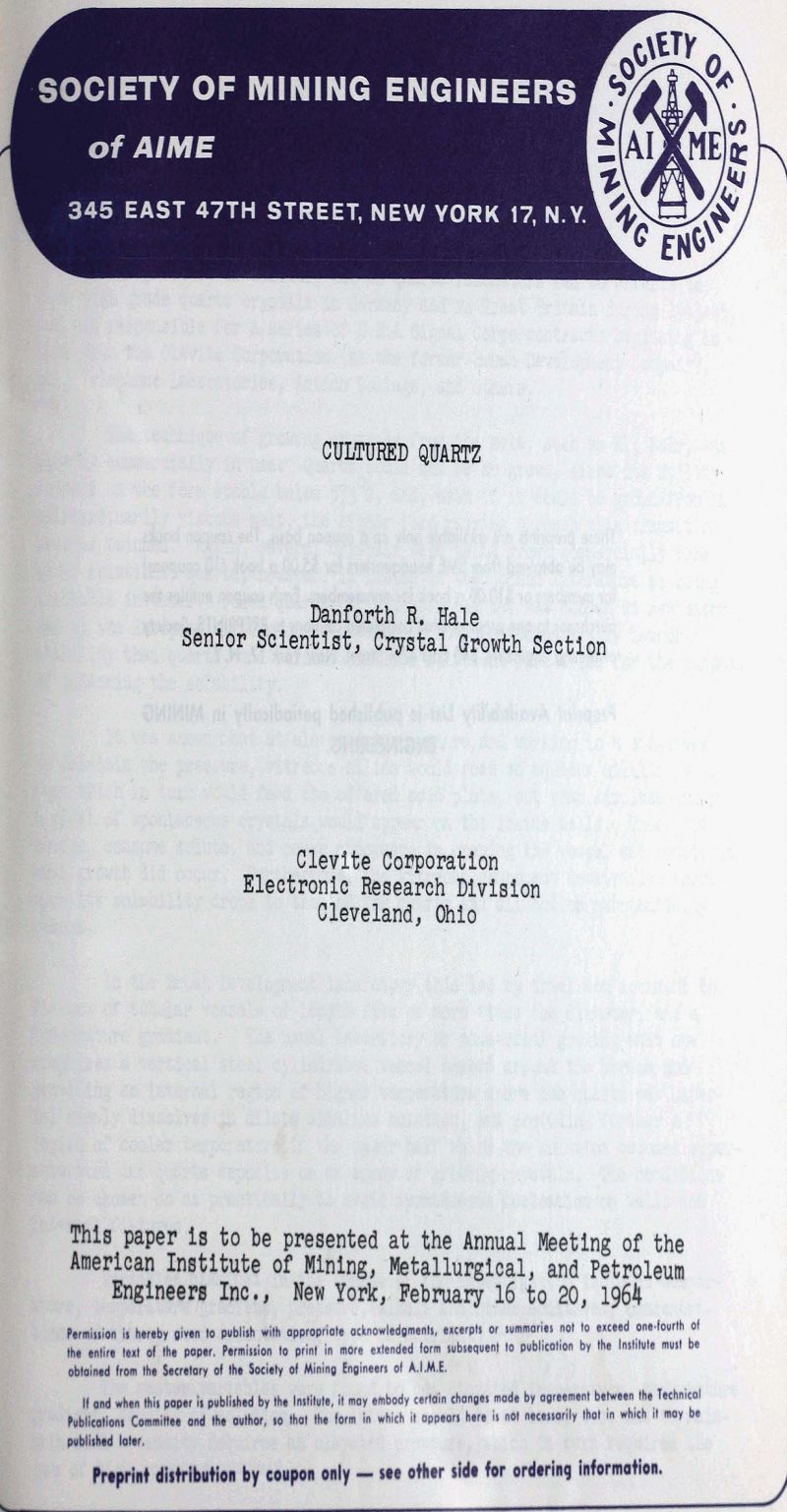The technique of growing crystals from the melt, such as KI, NaBr, was already commercially in use. Quartz could not be so grown, since its utility depends on the form stable below 573° C, and, even if it could be grown from an extraordinarily viscous melt, the higher form passing through this transition becomes twinned. Again, several crystals were being grown commercially from water solutions; quartz, however, is listed in the common literature as being insoluble in water. Fused quartz, or vitreous silica, was chosen as raw material by the European experimenters because of its thermodynamically lesser stability than quartz, and various alkaline solutions were tried for the purpose of enhancing the solubility.
It was shown that at elevated temperature, and working in a steel vessel to maintain the pressure, vitreous silica would feed an aqueous alkaline solution which in turn would feed the offered seed plate, but that simultaneously a, crust of spontaneous crystals would appear on the inside walls. These, of course, consume solute, and cause annoyance in opening the vessel and retrieving what growth did occur. Furthermore, the vitreous component devitrifies whereupon its solubility drops to that of the quartz and all action substantially ceases.
The master variables were found to be: elevated temperature, temperature gradient, density of solution. The latter should be at least 0.6, and to maintain such a density requires an elevated pressure, which in turn requires the use of high-pressure vessels.
The use of a seed plate of predetermined size, shape, and crystallography orientation, controls the type of growth (expressed as Z-growth, X-growth, minor-rhombohedral growth, etc.) and gives much control over the final size and shape. Natural quartz has grown mainly on the terminating rhombohedral faces. Hence plates cut parallel to the minor and major rhombohedral faces have been used as seed plates. An advantage of these is that the BT-cut and AT-cut resonators are closely parallel, respectively, to the major and minor faces; a disadvantage appears in the poor material efficiency when the crystals are grown fairly large because of the tapering ends caused by the development of prism faces on which almost no growth occurs.
The seeds are arranged with the thickness perpendicular to the beam direction, thus offering maximum absorption. The gammagraph provides the operator information on growth rate, and indicates when to close the experiment it has not been possible to obtain information on the quality of the crystals or on the positive absence of spontaneous crusts however, if the rate is similar to that of an earlier run yielding good results, then the conditions may be assumed propitious.
At present the status is the following:- Cultured quartz is excellent as a resonator material. It achieves equality with natural when grown in the Z-direction under carefully controlled conditions, and especially when it is also electrolyzed between platinum electrodes at elevated temperature (say with 400 V/cm at 400° C during two or three days). Cultured quartz surpasses natural quartz in freedom from twinning, uniformity in piezoelectric properties, and uniformity in size and shape.
Furthermore, cultured quartz is superior to natural quartz as an optical material, exhibiting a transmission spectrum extending beyond that of natural into the UV and IR regions.
The surface patterns, particularly on cultured quartz crystals, nave attracted attention as indicating possible dislocations in the structure. Mounds which suggested low-angle or vicinal faces were noted. Spiral patterns were found on two specimens of natural quartz. Two handsome spiral patterns visible to the eye were found at Clevite on minor rhombohedral growth cultured quartz. This was not long after spirals on crystals had been predicted as the logical result of screw dislocations, and then discovered on silicon carbide.
Longer etching with fluoride will often produce deep channels which are assumed to follow dislocation lines. The strained region along the length of a dislocation line in the quartz structure should show a much higher chemical reactivity or solubility than undisturbed quartz. Although a single dislocation line can be identified as a line of atoms or groups, the strain theoretically involves many atoms of distance, and practically, the channels produced, by HF are readily seen under the microscope.
Correlation between density of the observed line imperfections, which varied between zero and 10 4 lines per cm², and the Q of resonators made from the same crystal, was looked for at Clevite and not found. However, the Q-data was available from room temperature down only to liquid nitrogen temperature, and hence did not include the drop in Q at 20° K originally proposed as caused by dislocations. There is evidence that when obvious layering is found in the crystal the Q is reduced.

